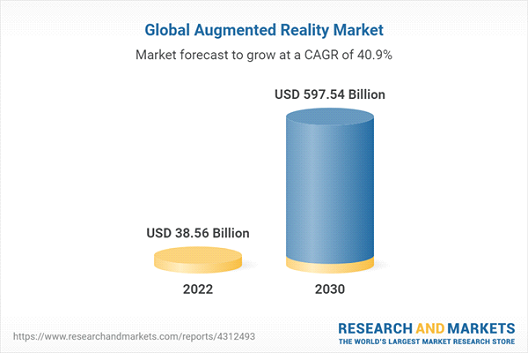
Augmented Reality in Marketing: Make Your Brand More Innovative

Augmented Reality - is a new buzzword in this digital world. Let’s check what AR actually means and what is the importance of augmented reality in marketing.
Augmented Reality (AR) has gained tremendous traction nowadays. The technology behind AR allows us to interact with real objects through our smartphones or other devices. Many businesses are now exploring ways to leverage AR to their advantage.
The use of Augmented Reality (AR) is rapidly expanding across many industries and businesses, especially those using mobile apps. One area where AR is having a profound effect is in marketing, specifically in how consumers perceive brands and retailers. Brands have been using AR to create interactive experiences for their customers, while retailers have harnessed AR to develop unique shopping experiences.
But what does this mean for marketers? And why is it important for marketers? How can brands use AR effectively in order to engage with their audience and increase brand awareness?
Nowadays, marketers believe they should adopt augmented reality (AR) for marketing in their strategy as they believe AR would positively impact their business.
In the future, we might even expect AR to become commonplace in our daily lives. If you’re interested in learning more about augmented reality, read our guide about the use of augmented reality in marketing.
What is Augmented Reality in Marketing?
Augmented reality in marketing means integrating AR technology into your marketing strategy or marketing content. AR is a trend that marketers should pay attention to because it allows them to create highly interactive experiences. Augmented Reality and marketing go hand in hand.
Augmented Reality (AR) refers to computer-generated images that are integrated into real environments. AR technologies are beginning to transform consumer products, such as smartphones, watches, and glasses. As these technologies become more mainstream, brands can capitalize on their potential to attract customers through rich multimedia experiences. AR offers a unique way to engage with consumers beyond text or voice communication alone. Brands can leverage existing assets to build meaningful AR experiences.
How is Augmented Reality Effective for Marketing?
Marketing through augmented reality (AR) has become very common. Nowadays, almost everyone owns a smartphone, and AR apps are becoming more and more popular. Still, some marketers are not using these tools effectively or at all. How effective have they been? This section discusses them.
AR helps brands gain visibility in different ways. Augmented reality marketing strategy is one of the latest marketing trends to provide customers with immersive, personal experiences that are accessible and convenient. Augmented Reality Marketing is a powerful tool that helps businesses increase engagement and enhance brand value in the most relatable way through mobile devices.
Marketers use AR to create experiences where customers can come into direct contact with a brand. They can see a product from all angles, get additional details about it, share items with friends and even purchase things directly from within an application. AR also allows manufacturers to provide a richer and more immersive experience to customers.
AR is useful in three areas: customer service, personalization, and advertising. In general, AR is a great way to extend a brand’s reach and communicate with customers. There are two main types of AR: location-based AR and object-based AR. Location-based AR uses GPS to track the user’s current position and then overlays virtual data onto the surrounding environment. Object-based AR displays a 3D model of a specific point of interest, such as a coffee cup, on top of the real world. Brands tend to leverage both methods to create experiences that provide value to their customers.
Is Augmented Reality the Future of Marketing?
Augmented Reality (AR) has become the hottest topic in tech. From games to advertising, AR promises to change our lives forever. Is it a fad or something truly revolutionary?
According to experts' predictions, augmented reality is the “next big thing.” Augmented Reality (AR) technology is changing the way consumers experience products and services.
We have seen businesses use AR technology to create interactive experiences where customers can virtually try on clothes before they buy them; learn how to cook with a chef using an app; learn about the new iPhone X directly from Apple without having to go into a store, and even get recommendations at a bar based on their tastes and preferences.
The possibilities for AR are endless. Augmented Reality Marketing will soon be commonplace among businesses. By learning to take advantage of this powerful technology, you will be able to capitalize on the opportunities that lie ahead of us and shape the future of marketing.
Augmented reality is certainly the future of marketing. Marketers should familiarize themselves with this emerging industry if they hope to stay relevant in today’s global marketplace.
Augmented Reality Market Size & Statistics
- 66% of people claim to be interested in using AR for assistance when shopping.
- 61% of consumers say they prefer retailers with AR experiences
- 5% of AR use will be in retail by 2022.
- By 2025, nearly every consumer (almost 75%) of the global population with almost all smartphone users will be an avid user of augmented reality.
- According to a survey report conducted by Deloitte, almost 90% of companies with annual revenues between $100 million and $1 billion are now utilizing AR technology.
Did you know? The global augmented reality market size is expected to expand at a compound annual growth rate of 40.9% from 2022 to 2030.

Benefits of Augmented Reality in Marketing
The benefits of augmented reality for marketing to enhance your marketing strategies include:
⦁ Engagement:One of the best things about augmented reality is that it offers a brand-new way to interact with customers. Customers can get hands-on with products without having to leave home. Through the use of smartphones and smart glasses, they can access product details and even try out the product themselves. Consumers do not have to go online to research items; instead, they can simply take pictures, videos, and measurements of the item with their phones. Users who would otherwise not purchase or visit a store can do so easily via an app and get rewarded with discounts, promotions, and loyalty incentives.
⦁ Reaching new audiences – AR gives brands the ability to reach consumers at the point of purchase. This creates greater brand awareness and increases customer loyalty.
⦁ Enabling better customer service – By placing virtual assistance agents in customers' homes, retailers can provide personalized service and increase customer satisfaction.
⦁ Interactive: Users can interact with products directly via touch screens, track purchases, and share their experiences with friends.
⦁ Personalization: Augmented reality provides opportunities to personalize interactions based on user interests, demographics, location, and other factors.
⦁ Multichannel: Marketers can use AR to connect with shoppers through multiple channels including in-store, online, phone calls, emails, text messages, social media, and even billboards.
3 Inspiring Examples of Augmented Reality in Marketing
Marketers using AR today include Coca-Cola, Volvo, McDonald’s, Nike, and KFC. There are two main ways brands can leverage AR: by creating experiences around their products or services that people interact with in real life, and by enhancing their advertising campaigns through interactive elements.
Below are a few examples of augmented reality in marketing:
⦁ Sephora - Augmented Reality app "Sephora Virtual Artist"
Sephora, the makeup retailer, and a big beauty brand introduced an Augmented Reality app "Sephora Virtual Artist". This AR app connects consumers to lipsticks they love and ultimately products for purchase. Sephora's AR app is a great way to learn about new products, find tips and tricks, and even shop online. Not only does it make shopping easier, but it also helps you save time since you don't have to go outside to look for information. The ability to leverage this exclusive augmented reality technology to mirror, the Sephora store makeover experience on the customer's own device is a game changer for Sephora's users.

⦁ IKEA - IKEA Place App to view the furniture virtually right at your home
IKEA Place works on the same “try before you buy” model, where it lets customers see what something looks like before they purchase it. IKEA's augmented reality app takes users on a journey inside their homes, showing them how objects in the real world could look in their own space. The app allowed users to place items from their homes onto a real-life scale model of their flats. The app uses IKEA's product data and applies it to a virtual representation of the user's home.

⦁ BIC Kids - The interactive drawing and painting experience for children
With the BIC®Kids DrawyBook app, designed specifically for kids aged 6-12 years old and their parents. You can make your drawings come alive and discover the interactive story through augmented reality as you scan the workbook's pages. A brand-new experience cleverly uses the digital world to enhance the appeal of drawing and colouring to children!

Augmented Reality - The Future Of Marketing And Sales
It's time to adapt to new technologies. Give your audience the chance to be captivated by the revolutionary experience that is Augmented Reality. Get your hands on AR and see the difference!
Enhance sales and marketing experiences with the help of MageAnts. Reach out to us for more information and powerful business solutions!
Recommended read:- 15 Best ECommerce Marketing Strategies For Your ECommerce Business
